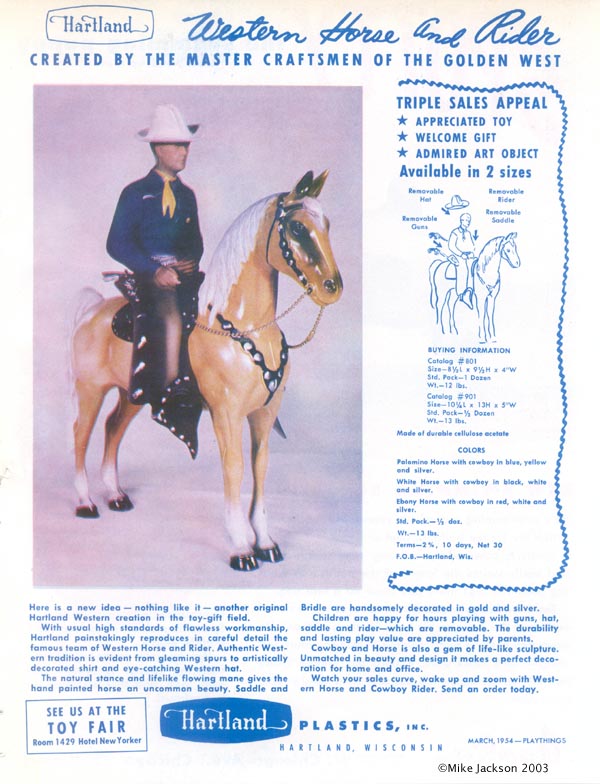Western Champ and His Master History
There are two topics regarding Hartland Plastics history that were either not well documented or incorrectly represented in some of the current literature and books on the subject. With a lot of help from other collectors, I wrote two important pages on my old site that need to be preserved for collectors. The other topic was about the Mastercrafters Horse Clocks.
Sometime in late 1953 or very early 1954, Hartland Plastics (using Hartland Molded as their trade name at the time) began producing the Western Horse and Rider sets as shown in the ad on the left. This is the earliest known ad showing a Hartland rider of any kind or color. The ad appeared in Playthings Magazine in March of 1954 and looks very much like the dealer sheets they produced in following years for their other horse and rider sets and gunfighters.
Until I saw this ad, I had never really seen nor heard of a Dealer Sheet for any “Champ” style horse and rider set. To be technically correct, the set was not called a Champ set in any of the earliest literature I have been able to find until the introduction of the insert sheet called “The Story of the Western Champ and His Master”…probably produced in mid-1954. Other horses on the Chief Thunderbird sheet indicated that some of the other horses had their own name, so it appears the name “Champ” was given to the Palomino horse in the beginning. Over the years, collectors have generically combined all the horse and riders sets under the single term “Champ Sets”.
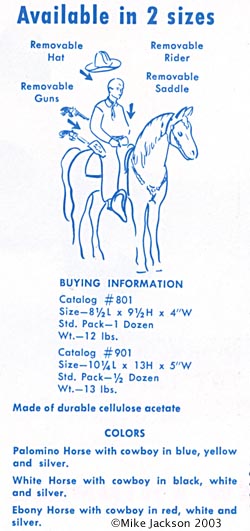 The detail on the left is from the dealer sheet/ad above. There two important tidbits of information here. First, the notation the sets were available in two sizes and secondly, the list of color schemes available at the time of introduction. There is no mention of a Cowgirl set in this piece of literature. A later September 1954 Playthings press release indicates the cowgirls weren’t released until early Fall of that year. (That photo will be shown later on this page)
The detail on the left is from the dealer sheet/ad above. There two important tidbits of information here. First, the notation the sets were available in two sizes and secondly, the list of color schemes available at the time of introduction. There is no mention of a Cowgirl set in this piece of literature. A later September 1954 Playthings press release indicates the cowgirls weren’t released until early Fall of that year. (That photo will be shown later on this page)
With little reliable information to work with, I have always assumed the Black Cowboy in the large size was first, followed by the other two color schemes of the large set. I had also speculated that the large Cowgirl was available before the smaller 800 series rider, but this sheet sets the record straight.
The first appearance of this set appeared in the 1955 brochures as “Western Champ and His Master”
The Hartland large horse had been around as an individual statue, along with a short seat saddle, for at least a year prior to the introduction of a rider. The actual first 900 series sized horse mold had been around for several years prior to Hartland selling it individually. The horse was originally produced in mid-1950, following their Mastercrafters clock deal.
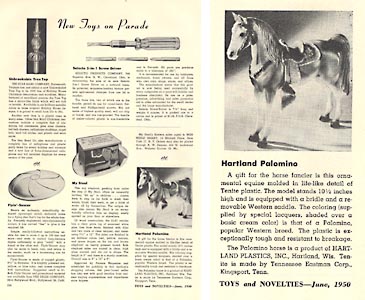 Contrary to what we have always, thought, the horse Hartland used for the Mastercrafters clock was actually a horse most collectors call the “Breyer” horse. The ad on the left indicates Hartland did in fact create that horse. I am fairly confindent the image shown here was simply a placeholder while they were finishing their new version of that horse with the traditional tail and mane.
Contrary to what we have always, thought, the horse Hartland used for the Mastercrafters clock was actually a horse most collectors call the “Breyer” horse. The ad on the left indicates Hartland did in fact create that horse. I am fairly confindent the image shown here was simply a placeholder while they were finishing their new version of that horse with the traditional tail and mane.
I have yet to see any firm documentation to convince me that Hartland’s first small rider was introduced prior to Breyer’s first Indian figure. Nancy Young, Breyer expert and author of numerous editions of the quintessential Breyer book, indicates that Breyer introduced their Indian on a Western Pony in early 1953, or possibly even earlier. The evidence I am seeing now, points to the probability that Breyer produced their smaller Western Pony before Hartland produced their smaller 800 series “Champ” style horse.
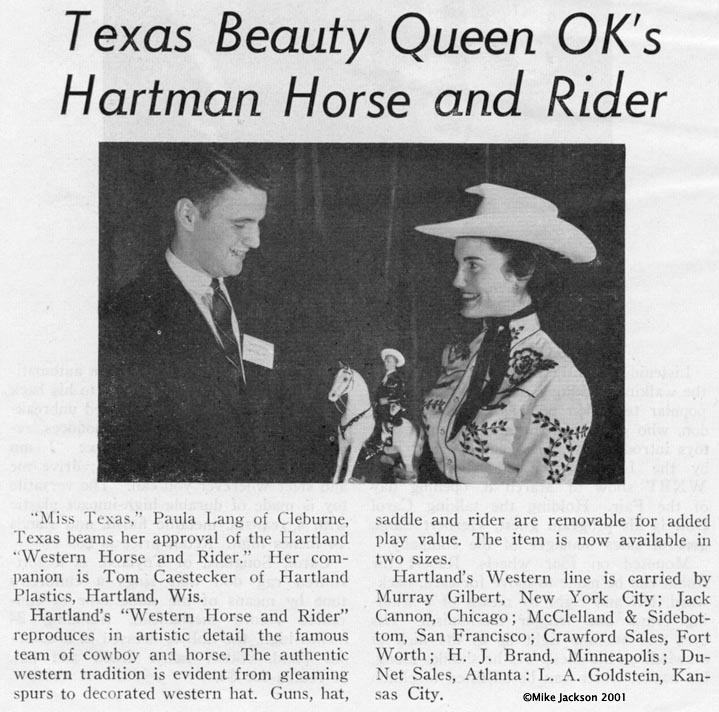
Miss Texas is seen holding a Large Black Champ horse and rider set in an April, 1954 issue of Playthings magazine. Until I was able to find the dealer sheet/ad at the top of the page, this photo was the earliest known photo of a Hartland Cowboy and Horse—it led to part of my assumption that the Black Cowboy set was the first one. The caption also indicates there was a smaller version available, but no mention of a Cowgirl set.
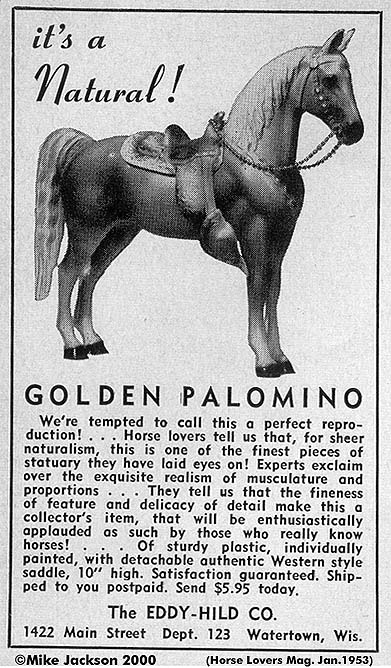
The horse shown to the left is the horse mold Hartland produced in mid-1950. It is different than the one used on the Mastercrafters clock, however a few have been added to old clock bases. This ad shows a large Champ horse from January of 1953 and it shows up again in October of 1953. There is no mention of a smaller horse being available—nor a rider. If a rider had been available by press time for the October ad, it would make sense the figure would have been included in the photo and description. Additionally, the dealer sheet/ad at the top of the page implies the horse and rider set was a new introduction.
As stated in the first paragraph, all available documentation indicates the horse and rider sets were introduced in very late 1953 or early 1954.
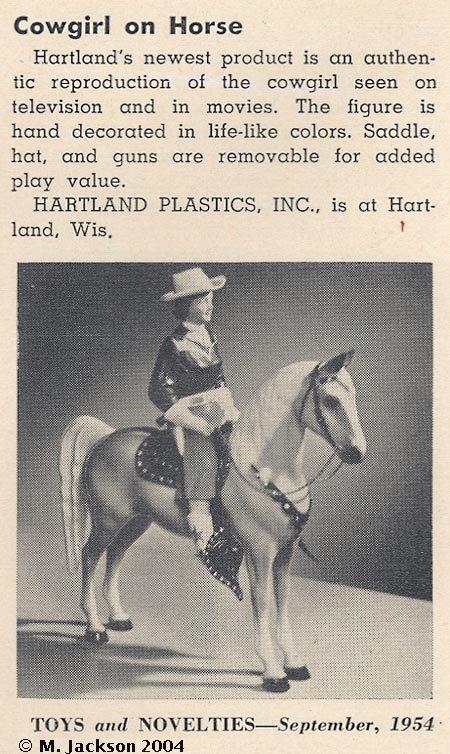
This press release appeared in Playthings Magazine (a national toy trade magazine) in September of 1954. As the headline indicates, the Cowgirl was a Hartland’s latest statuette which positively pins her introduction to much later in the year than the two sizes of Cowboys. The set in the photo on the left is a Jade Green version and it appears to be one of the 900 series sets on the later “solid mane” horses. There is no mention of another color scheme, nor of a smaller size being available.
The Jade Green cowgirls in both the large and small sizes are quite a bit harder to find than the red and white versions, so it seems this color combination did not last too long.
(Thanks to Bruce Schwartz for the scan of the release)
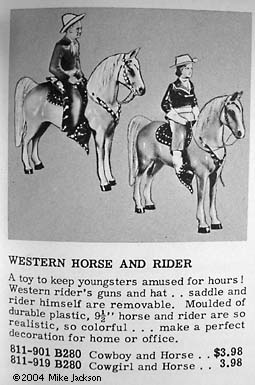
This offering appeared in a 1955 John Plain catlog. The postal rate chart was dated for October 1, 1954, so these two pieces dovetail into the time line nicely. The large Cowgirl set shown in the Sept. 1954 Playthings release was now available in an October catalog. Both sets appear to be on early versions of the Palomino horse. These two ads at least suggest the Jade Green Cowgirl was Hartland’s first Cowgirl color scheme. The split mane on these horses indicate the earlier style, however, the horse shown in the press release was the later horse.
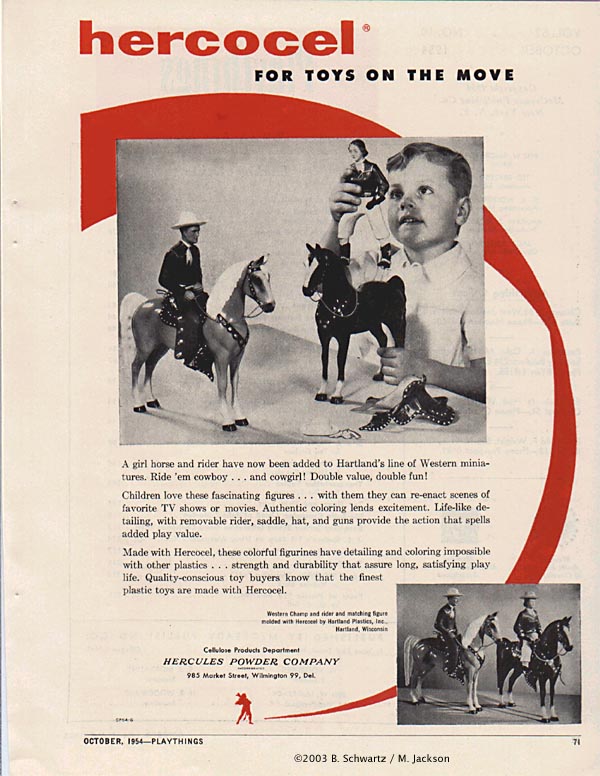
This press release appeared in Playthings magazine in October, 1954, reinforcing the later dating of the Cowgirl. The close up below indicates Hercules Powder Company was was a supplier of Hercocel to the factory—the cellulose acetate used in at least the early Hartlands. The close up also reveals some of the first uses of the “Western Champ” terminology.
(Thanks to Bruce Schwartz for the scan of the release)
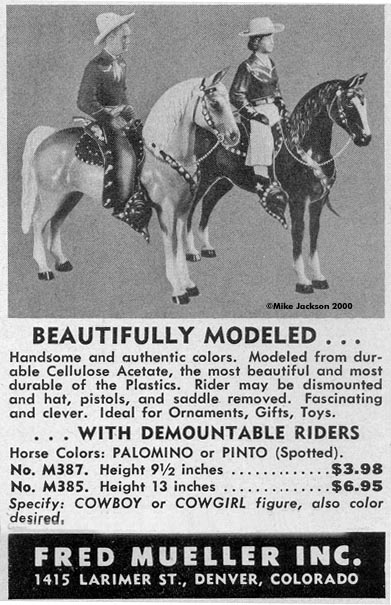
By the time the ad above came out in December of 1954 in Western Horseman Magazine, Hartland had settled into the more common color schemes for the Cowboys and Cowgirls. As indicated here, both sizes were available in each version, AND it indicates Pintos were also available.
Both horses shown here have the split mane style early 900 series horse, originally produced mid-1950. Eventually, Hartland created a new mold for the 900 series horse which did not have the split mane and the scallops on the top of the martingale were removed. It more closely matched the style of the smaller 800 series horse.
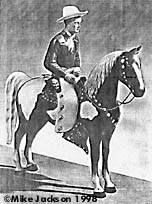
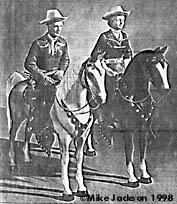
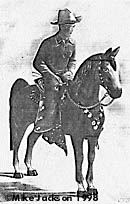
The three photos above are from photocopies of photocopies of Hartland photos taken by their company in their trademark poses. (I don’t know who has the originals, or even if they still exist!) The two on the left generally reflect the descriptions in the Fred Mueller, Inc ad above, while the one on the right seems more “illustrated” than photographed. I’d say it was some form of early prototype piece of literature. I have never seen any of the three used in any ad or printed Hartland literature, but they almost have to exist somewhere.
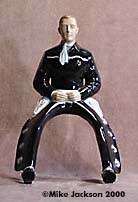
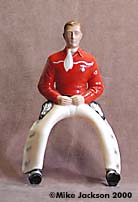
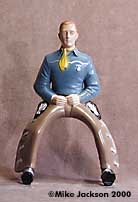
The photos above show the three figure color schemes. Collectors seem to call them: The All Black Champ, Red and White Champ, and the Brown and Blue Champ even though Hartland generally called them Cowboys or Western Riders.
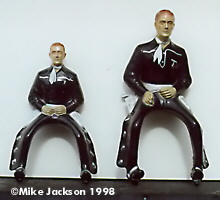
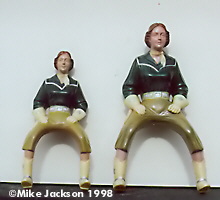
For size comparison, the figure on the right is a 900 series Black Champ Cowboy. The smaller Champ Cowboys are molded in solid black plastic and then the silver, white and flesh accents are painted over it. All other 800 series Champ Cowboys were molded in white plastic and then over painted with the correct colors. Most of the larger 900 series Black Champ Cowboys were also molded in white plastic, however, it does appear that at least a few were molded in black plastic. All of the Large Black Cowboys, that I am aware of, have a cigarette in his right hand. Many of the later Large Champ Cowboys lacked that feature. None of the Small Champ Cowboys held a cigarette.
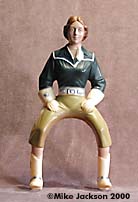
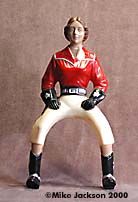
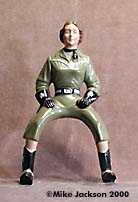
Champ Cowgirls:
Hartland made the large and small versions of the two Cowgirls above. Unlike the Cowboys, she carried only one gun. Cowgirls were assigned a model number of either 802 or 902 numbers, depending on which size.
 The olive green Cowgirl on the right above, is commonly called the “Early Green Dale Evans” and she rode a light dun colored horse with brown points as shown in the photo on the left. (The photo came from a Farwell Hardware catalog from probably early 1955.) That version of the Dale Evans figure was replaced with the newer one later in 1955. Both versions used the 802 (DE) designation.
The olive green Cowgirl on the right above, is commonly called the “Early Green Dale Evans” and she rode a light dun colored horse with brown points as shown in the photo on the left. (The photo came from a Farwell Hardware catalog from probably early 1955.) That version of the Dale Evans figure was replaced with the newer one later in 1955. Both versions used the 802 (DE) designation.
Hartland printed an insert sheet to be included with the large Western Horse and Rider sets and later a sheet which was included with many early Chief Thunderbird sets. The Chief Thunderbird sheet looks like Hartland’s very first attempt at a brochure, listing additional sets that were available at the time. That list identifies other Champ style horse and rider sets by name and the information is very valuable here.
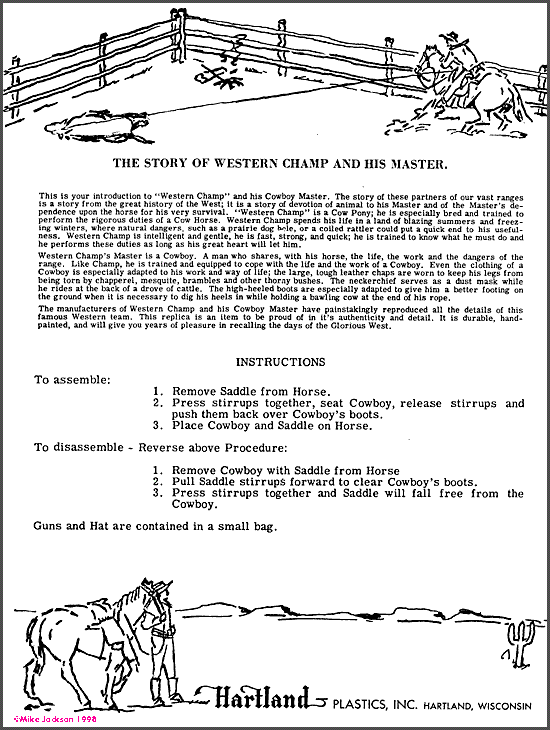
The Story of the Western Champ and His Master:
This page probably was produced in 1954 to be inserted with the Large Champ horse and riders. The lower section explains how to put the cowboy and saddle onto the horse and also how to remove it. That wouldn’t have been necessary on the smaller sets since they slip right off and on.
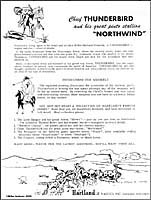
Chief Thunderbird instructions:
A very similar sheet, probably printed about the same time gives information about the Chief Thunderbird 800 series set and it lists other sets available at the time—all Champ style horse and riders (except the T-Bird set of course). I believe this sheet also dates to about the middle of 1954 or maybe a little later.
Near the bottom of the Chief Thunderbird sheet, the additional sets were described as:
“Hey why not start a collection of Hartland’s Famous series? Here they are, all beautifully molded, and hand decorated in beautiful detail. Ideal collection pieces.
1. The Lone Ranger and his great horse “Silver”—just like you see him on television. The authentic masked rider and his wonder horse—complete in every detail.
2. “Western Champ”, the golden palomino, and his cowboy master.
3. Chief Thunderbird and his great pinto war-horse, “Northwind”.
4. The Wrangler on his favorite pinto quarter-horse, “Paint”. (Also available riding beautiful ebony “Blacksnake” or white “Starlight”).
5. The Cowgirl riding either a Palomino, white or black horse.
Noting this sheet contains a reference to The Lone Ranger, it was probably not printed until later in the fall of 1954. Documents below confirm the introduction during that period and the dated press release in Playthings Magazine helps confirm chronological ordering.
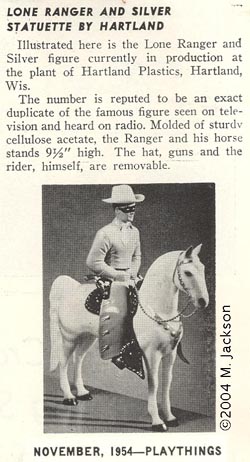
By sometime in the fall of 1954, Hartland changed the color of their 900 & 800 series riders to powder blue and added a mask to call the set “The Lone Ranger”—commonly called the Champ Style Lone Ranger by collectors. (Note the press release on the left, dated from a 1954 Playthings magazine) This seems to mark the beginning of the TV linked horse and rider sets, with the exception of the generic Lance O’Rourke and Chief Thunderbird sets. For a temporary period of time, the Cowgirl figure was switched to green and put on a light dun colored Champ horse and given the name “Dale Evans” to go with their new Roy Rogers mold. Roy was introduced on a Champ style horse sometime around beginning of 1955 at the New York Toy Fair.
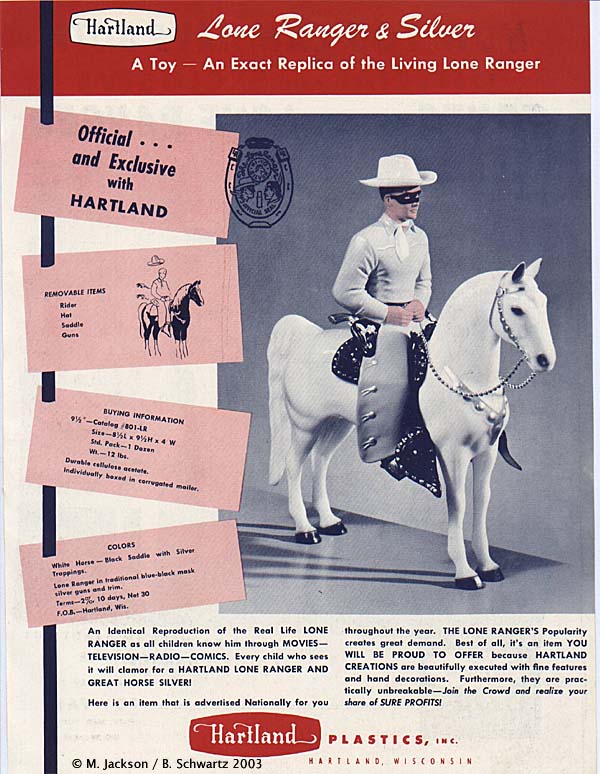
Lone Ranger from late-1954 Dealer Sheet:
The first Lone Ranger sets would have been a Champ style set like the one to the right. Many of the early Lone Ranger sets are marked with a rubber stamp dating it with 1954. As listed in the Chief Thunderbird sheet above, The Wrangler would have been the Red and White Champ Cowboy, while the Cowboy Master that went with the Palomino would have been the Brown and Blue figure. According to this literature, the only horse to actually get the name “Champ” was the Palomino version. Over the years, all of that style have been called Champs—along with the same designation for any of that style riders with the chaps. (Thanks to Bruce Schwartz for the scan of his sheet)
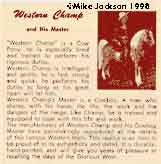 The End of the Trail:
The End of the Trail:
As Hartland began the change over to additional named western sets, it marked the beginning of the end for the generic Champ sets. The Western Champ and his Master first appeared in the brochures in 1955, listed with a lot of other 800 series sets but shown with a 900 series set in the brown/blue/palomino combination. I have documentation indicating that Hartland sold some of the 800 series Red and White Champ Cowboy sets at least as late as June, 1958 though they were removed from the brochures after 1957. More than likely, sets sold after 1957 were probably from inventory stock, as opposed to newly produced pieces.
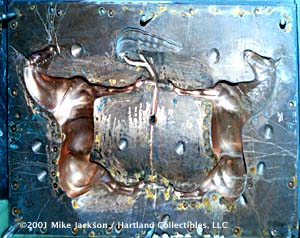
900 Large Champ Horse Mold:
There were two slightly different Large Champ horse molds. This one has the solid mane, suggesting it was the later one. According to Sheryl Leisure, the person at Hartland Collectibles, LLC who took the photos, this one does not have a hole in its back You can see the tail at the top of the photo. This mold does not have a saddle included in it.
(Thanks to Hartland Collectibles, LLC for this exclusive photo!)
Related Links:
Mastercrafters Horse Clocks
Official Site of the American International TOY FAIR
Special thanks to: Denise Deen, Phil Duncan, Jo Kulwicki, Hartland Collectibles, LLC, George C. Jones, Sheryl Leisure, Bruce Schwartz, Sande Schneider, Joy Sheesley, Heather Wells, Nancy Young, and a long list of others!
In July of 2022, Darla and I made the tough decision to sell out in Jackson Hole and move to a new home in Colorado. With limited space, I sent my entire collection of Hartland sets and boxes to an auction company. I still have a nice group of original parts, and some religious sets and pieces but I don’t have any boxes available now.
When I sold many of the sets, I pulled off many of the original parts to sell in the future. I have a lot of saddles, hats and weapons…just need to dedicate the time to photograph and list the pieces I have.
While I probably “should” close this site, I have left some of the old Hartland History pages, such as the Champ and Mastercrafters Clocks pages available. The pages corrected information found in some of the available books.
MJ
Mike Jackson 3588 Gold Hill Dr. – Loveland, CO 80538
E-MAIL
All Images and text on this site copyright Mike R. Jackson 1998-2024

